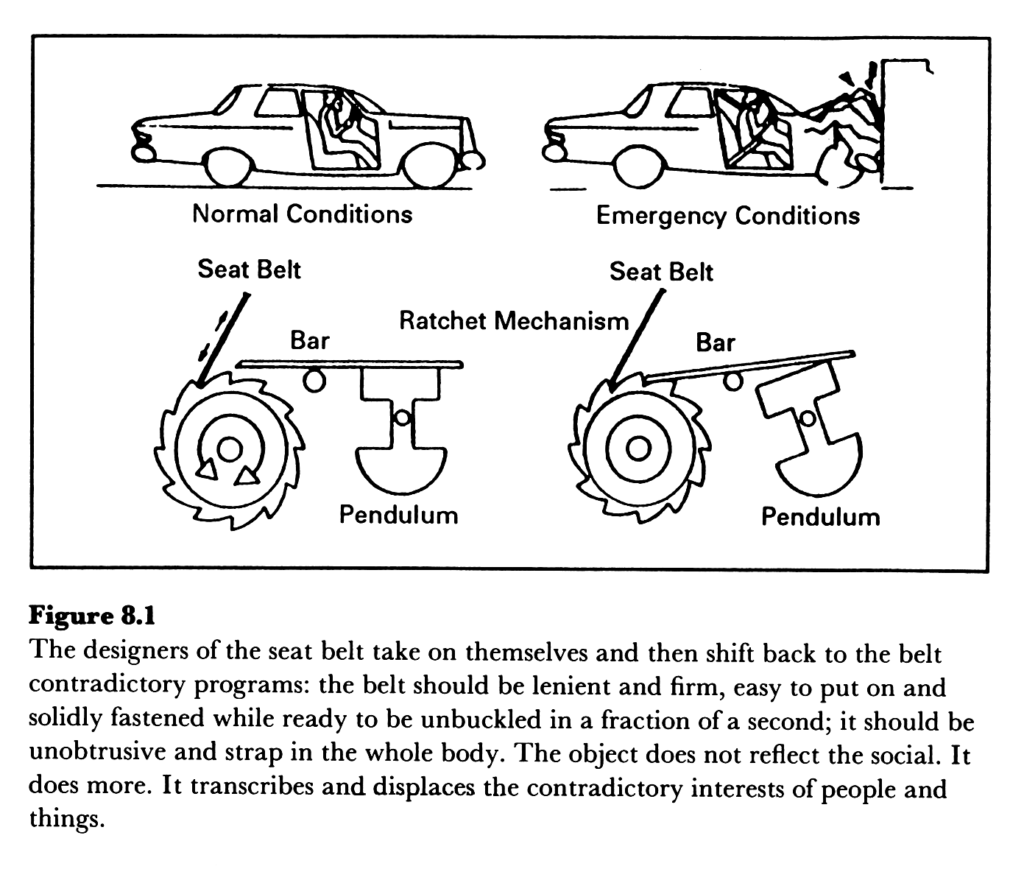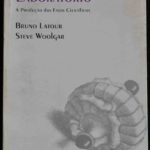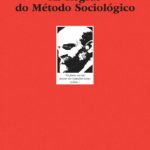
Onde estão as massas ausentes? (Latour 1992)
LATOUR, Bruno. 1992. Where are the missing masses? The sociology of a few mundane artifacts. In: Wiebe E. Bijker; John Law (eds.). Shaping technology/building society: studies in sociotechnical change. Cambridge: The MIT Press, pp.225-58.
O SILÊNCIO e a GLÓRIA das MÁQUINAS (Samuel Butler)
(Latour 1992:225)
PROGRAMA DE AÇÃO (script)
A program of action is the set of written instructions that can be substituted by the analyst to any artifact. Now that computers exist, we are able to conceive of a text (a programming language) that is at once words and actions. How to do things with words and then turn words into things is now clear to any programmer. (Latour 1992:225 nota 1)
THE SCRIPT and the SCRIPTER (god?)
The scripter or designer of all these scripts is itself (himself, herself, themselves) negotiated. (Latour 1992:256 nota 13)
COLOQUE O CINTO DE SEGURANÇA (moralidade distribuída=fortalecida e a lei do terceiro excluído)
(Latour 1992:226)
DISTRIBUIÇÃO DE COMPETÊNCIAS (Latour 1992:233)
AS MASSAS AUSENTES DA SOCIOLOGIA
To balance our accounts of society, we simply have to turn our exclusive attention away from humans and look also at nonhumans. Here they are, the hidden and despised social masses who make up our morality. They knock at the door of sociology, requesting a place in the accounts of society as stubbornly as the human masses did in the nineteenth century. What our ancestors, the founders of sociology, did a century ago to house the human masses in the fabric of social theory, we should do now to find a place in a new social theory for the nonhuman masses that beg us for understanding. (Latour 1992:227)
[SCRIPTS que são DESEMPENHADOS por [ACTANTES; que podem ser HUMANOS ou [NÃO-HUMANOS; que podem ser FIGURATIVOS ou NÃO-FIGURATIVOS]]] (Madeleine Akrich)
(Latour 1992:255 nota 3)
DESCRIÇÃO (manuais, instruções, demonstrações, treinamentos, experimentos mentais de alternativas, processo criativo, grupos focais, deciframentos de funcionamentos desconhecidos, tabelas abstratas de ausências-presenças)
I will call the retrieval of the script from the situation de-scription. They define actants, endow them with competences, make them do things, and evaluate the sanction of these actions (Latour 1992:255 nota 4)
Although most of the scripts are in practice silent, either because they are intra- or extrasomatic, the written descriptions are not an artifact of the analyst (technologist, sociologist, or semiotician), because there exist many states of affairs in which they are explicitly uttered. The gradient going from intrasomatic to extrasomatic skills through discourse is never fully stabilized, and allows many entries revealing the process of translation: user manuals, instruction, demonstration or drilling situations, practical thought experiments (“what would happen if, instead of the red light, a police officer were there”). To this should be added the innovator’s workshop, where most of the objects to be devised are still at the stage of projects committed to paper (“if we had a device doing this and that, we could then do this and that”); market analysis in which consumers are confronted with the new device; and, naturally, the exotic situation studied by anthropologists in which people faced with a foreign device talk to themselves while trying out various combinations (“what will happen if I attach this lead here to the mains?”) The analyst has to empirically capture these situations to write down the scripts. When none is available, the analyst may still make a thought experiment by comparing presence/absence tables and collating the list of all the actions taken by actors (“if I take this one away, this and that other action will be modified”). […] In practice [not a priori] […], the scripts are explicit and accountable. (Latour 1992:255-6 nota 5)
As a more general descriptive rule, every time you want to know what a non-human does, simply imagine what other humans or other non-humans would have to do were this character not present. This imaginary substitution exactly sizes up the role, or function, of this little character. (Latour 1992:229) [MAIS PRECISAMENTE: O TRABALHO HUMANO QUE IMAGINAMOS SER ANÁLOGO AO TRABALHO NÃO-HUMANO GERALMENTE NÃO É O TRABALHO QUE O NÃO-HUMANO EFETIVAMENTE SUBSTITUI, MAS SIM O TRABALHO QUE OS HUMANOS PASSARÃO A TER QUE FAZER NA AUSÊNCIA DO NÃO-HUMANO. I.E.: antes do automóvel ninguém se deslocava muito, então ele não substitui um trabalho de deslocamento pré-existente, mas cria este trabalho para aqueles que não têm automóvel)
INSCRIÇÃO
We call the translation of any script from one repertoire to a more durable one transcription, inscription, or encoding. This definition does not imply that the direction always goes from soft bodies to hard machines, but simply that it goes from a provisional, less reliable one to a longer-lasting, more faithful one. For instance, the embodiment in cultural tradition of the user manual of a car is a transcription, but so is the replacement of a police officer by a traffic light; one goes from machines to bodies, whereas the other goes the opposite way. Specialists of robotics have abandoned the pipe dream of total automation; they learned the hard way that many skills are better delegated to humans than to nonhumans, whereas others may be taken away from incompetent humans. (Latour 1992:256 nota 6)
AGÊNCIA GENERALIZADA (ação-rede)
In this kind of analysis there is no effort to attribute forever certain competences to humans and others to nonhumans. The attention is focused on following how any set of competences is distributed through various entities. (Latour 1992:256 nota 9)
DAEDALUS
(Latour 1992:256 nota 10)
ACTANTE, ATOR
We use actant to mean anything that acts and actor to mean what is made the source of an action. This is a semiotician’s definition that is not limited to humans and has no relation whatsoever to the sociological definition of an actor by opposition to mere behavior. For a semiotician, the act of attributing “inert force” to a hinge or the act of attributing it “personality” are comparable in principle and should be studied symmetrically. (Latour 1992:256 nota 11)
DESCRIÇÃO DE UMA PORTA (O porteiro está em greve, pelo amor de deus mantenham a porta fechada)
This fusion of labor relations, religion, advertisement, and technique in one insignificant fact is exactly the sort of thing I want to describe in order to discover the missing masses of our society. (Latour 1992:227)
PORTA = PAREDE MÓVEL (o trabalho da dobradiça e o demônio de Maxwell)
So, to size up the work done by hinges, you simply have to imagine that every time you want to get in or out of the building you have to do the same work as a prisoner trying to escape or as a gangster trying to rob a bank, plus the work of those who rebuild either the prison’s or the bank’s walls. If you do not want to imagine people destroying walls and rebuilding them every time they wish to leave or enter a building, then imagine the work that would have to be done to keep inside or outside all the things and people that, left to themselves, would go the wrong way. As Maxwell never said, imagine his demon working without a door. […] [T]he hinged door allows a selection of what gets in and what gets out so as to locally increase order, or information. (Latour 1992:228)
DESLOCAMENTO=TRADUÇÃO=DELEGAÇÃO=ALTERAÇÃO (displacement=translation=delegation=shifting)
I will define this transformation of a major effort into a minor one by the words displacement or translation or delegation or shifting; I will say that we have delegated (or translated or displaced or shifted down) to the hinge the work of reversibly solving the wall-hole dilemma. (Latour 1992:229)
MINI-MAXES (Arquimedes e tecnopolítica)
in effect, we have drawn a scale where tiny efforts balance out mighty weights; the scale we drew reproduces the very leverage allowed by hinges. That the small be made stronger than the large is a very moral story indeed (think of David and Goliath); by the same token, it is also, since at least Archimedes’ days, a very good definition of a lever and of power: what is the minimum you need to hold and deploy astutely to produce the maximum effect. […] I contend that this reversal of forces is what sociologists should look at in order to understand the social construction of techniques (Latour 1992:)
A ESCOLHA MUMFORDIANA (substituir muitos humanos indisciplinados por um humano disciplinado)
Closing doors would appear to be a simple enough piece of know-how once hinges have been invented, but, considering the amount of work, innovations, sign-posts, and recriminations that go on endlessly everywhere to deep them closed (at least in northern regions), it seems to be rather poorly disseminated. […] This is where the age-old Mumfordian choice is offered to you: either to discipline the people or to substitute for the unreliable people another delegated human character whose only funcion is to open and close the door. […] The advantage is that you now have to discipline only one human and may safely leave the others to their erratic behavior. […] A nonhuman (the hinges) plus a human (the groom) have solved the wall-hole dilemma. […] Solved? Not quite. […] Although there is now only one human to be disciplined instead of hundreds, the weak point of the tactic can be seen: if this one lad is unreliable, then the whole chain breaks down; if he falls asleep on the job or goes walkabout, there will be no appeal: the door will stay open (Latour 1992:230)
https://www.youtube.com/watch?v=J7vxXfRhPf8
https://www.youtube.com/watch?v=mvrrzWe4rUw
SUBSTITUIÇÃO 1 (humano=>não-humano) x SUBSTITUIÇÃO 2 (muitos humanos=>um humano) = passado X presente
Although they appear to be two similar delegations, the first one is concentrated at the time of installation, whereas the other is continuous; more exactly, the first one creates clear-cut distinctions between production, installation, and maintenance, whereas in the other the distinction between training and keeping in operation is either fuzzy or nil. The first one evokes the past perfect (“once hinges had been installed…”), the second the present tense (“when the groom is at his post…”). There is a built-in inertia in the first that is largely lacking in the second. (Latour 1992:231)
O FECHADOR AUTOMÁTICO DE PORTA e a PRESCRIÇÃO
A nonhuman (hinges) plus another nonhuman (groom) have solved the wall-hole dilemma. […] Solved? Well, not quite. […] We have all experienced having a door witha powerful spring mechanism slam in our faces. […] The interesting thing with such impolite doors is this: if they slam shut so violently, it means that you, the visitor, have to be very quick in passing through and that you should not be at swomeone else’s heels, otherwise your nose will get shorter and bloody. […] I will call […] the behavior imposed back onto the human by nonhuman delegates prescription. Prescription is the moral and ethical dimension of mechanisms. (Latour 1992:232)
PRESCRIÇÃO (a dimensão moral dos mecanismos)
We call prescription whatever a scene presupposes from its transcribed actors and authors (this is very much like “role expectation” in sociology, except that it may be inscribed or encoded in the machine). For instance, a Renaissance Italian painting is designed to be viewed from a specific angle of view prescribed by the vanishing lines, exactly like a traffic light expects that its users will watch it from the street and not sideways (French engineers often hide the lights directed toward the side street so as to hide the state of the signals, thus preventing the strong temptation to rush through the crossing at the first hint that the lights are about to be green: this prescription of who is allowed to watch the signal is very frustrating); “User input” in programming language, is another very telling example of this inscription in the automatism of a living character whose behavior is both free and predetermined. (Latour 1992:256 nota 8)
EXPLICITANDO PRESCRIÇÕES
How can the prescriptions encoded in the mechanism be brought out in words? By replacing them by strings of sentences (often in the imperative) that are uttered (silently and continuously) by the mechanisms for the benefit of those who are mechanized: do this, do that, behave this way, don’t go that way, you may do so, be allowed to go there. Such sentences look very much like a programming language. This substitution of words for silence can be made in the analyst’s thought experiments, but also by instruction booklets, or explicitly, in any training session, through the vo8ice of a demonstrator or instructor or teacher. […] Another way of hearing what the machines silently did and said are the accidents. […] This description of a machine […] retraces the steps made by the engineers to transform texts, drafts and projects into things. (Latour 1992:233)
PRESCRIÇÃO e DISCRIMINAÇÃO
Because of their prescriptions, these doors discriminate against very luittle and very old persons. Also, if there is no way to keep them open for good, they discriminate against furniture removers and in general everyone with packages (Latour 1992:234)
MATERIALIDADE e MORALIDADE
We have been able to delegate to nonhumans not only force as we have known it for centuries but also values, duties, and ethics. […] The sum of moralityh does not only remain stable but increases enormously with the population of nonhumans. (Latour 1992:232)
The nonhumans take over the selective attitudes of those who engineered them. (Latour 1992:233)
OS TRÊS ANTROPOMORFISMOS DO FECHADOR AUTOMÁTICO DE PORTA
The groom is indeed anthropomorphic, in three senses: first, it has been made by humans; second, it substitutes for the actions of people and is a delegate that permanently occupies the position of a human; and third, it shapes human action by prescribing back what sort of people should pass through the door. (Latour 1992:235)
ANTROPOMORFISMO COMO QUESTÃO (e não acusação)
But anyway, who are sociologists to decidee the real and final shape (morphos) of humans (anthropos)? To trace with confidence the boundary between what is a “real” delegation and what is a “mere” projection? […] The debates around anthropomorphism arise because we believe that there exist “humans” and “nonhumans”, without realizing that this attribution of roles and action is also a choice. (Latour 1992:236)
SUBSCREVER (ou DESINSCREVER [de-inscript]) À PRESCRIÇÃO
I built up an inscribed reader to whom I prescribed qualities and behavior, as surely as a traffic light or a painting prepare a position for those looking at them. Did you underwrite or subscribe this definition of yourself? (Latour 1992:)
There might be an enormous gap between the prescribed user and the user-in-the-flesh […]. On other occasions, however, tha gap between the two may be nil: the prescribed user is so well anticipated, so carefully nested inside the scenes, so exactly dovetailed, that it does what is expected. (Latour 1992:237)
PRÉ-INSCRIÇÃO
no scene is prepared without a preconceived idea of what sort of actors will come to occupy the prescribed positions. […] This way of counting on earlier distribution of skills to help narrow the gap between built-in users or readers and users- or readers-in-the-flesh is like a pre-inscription. […] The fascinating thing in text as well as in artifact is that they have to thoroughly organize the relation between what is inscribed in them and what can/could/should be pre-inscribed in the users. (Latour 1992:237)
CIRCUNSCRIÇÃO
We call circumscription the organization in the setting of its own limits and of its own demarcation (doors, plugs, hall, introductions). (Latour 1992:257 nota 17)
(Latour 1992:)





 LaSPA is located at the Institute of Philosophy and Human Sciences (
LaSPA is located at the Institute of Philosophy and Human Sciences (